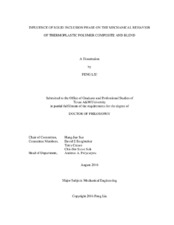| dc.contributor.advisor | Sue, Hung-Jue | |
| dc.creator | Liu, Peng | |
| dc.date.accessioned | 2017-03-02T16:43:38Z | |
| dc.date.available | 2018-08-01T05:58:21Z | |
| dc.date.created | 2016-08 | |
| dc.date.issued | 2016-08-10 | |
| dc.date.submitted | August 2016 | |
| dc.identifier.uri | https://hdl.handle.net/1969.1/158930 | |
| dc.description.abstract | The objective of this work is to investigate the influences of the solid inclusion phase on the physical and mechanical properties of the thermoplastic polymer composites, as well as the mechanisms that cause the properties’ deterioration upon exposure to hydrothermal environment. In order to obtain fundamental understanding of structure-property relationships of multicomponent polymeric materials, this dissertation work focuses on two important factors, which are the spatial dispersion of the inclusion phase, as well as its interface with the polymer matrix. Two different systems, polypropylene containing multiwalled carbon nanotubes (MWCNTs) and poly(ether ether ketone) (PEEK) containing 50 wt.% of poly(benzimidazole) (PBI) particles were employed as model systems.
Remarkable increases in modulus and strength of polypropylene, containing only trace amounts (0.1 wt.%) of individually dispersed F-MWCNTs were observed. The influence of the individually dispersed F-MWCNTs on the morphology of the crystal domains of PP and the mechanisms responsible for the observed increases in modulus and strength were examined.
PBI particles (average size 50 μm) were blended as an inclusion phase with PEEK to form a 50:50 weight ratio blend. The objective of this work is to investigate the reinforcing effect of PBI on performance in high temperature operating regimes (above 250°C). The interfacial affinity between PEEK and PBI at various conditions has been systematically studied by investigating the fracture behavior of PEEK/PBI blend. In addition, all samples were studied by polarized optical microscopy and dynamic mechanical analysis (DMA) to establish correlation between the morphology and properties. An underexplored aspect of this blend system is connected with the tendency of the PBI component to absorb and retain significant amounts of moisture. The effect of retained moisture on the performance of this type of blend in certain application environments is poorly understood. This dissertation work investigates the mechanisms that cause the mechanical property deterioration of PEEK/PBI blends on exposure to hot water at 288°C. In order to determine the underlying physics linked to property decrease, PEEK/PBI blends were subjected to several different treatments prior to characterization. | en |
| dc.format.mimetype | application/pdf | |
| dc.language.iso | en | |
| dc.subject | polymer | en |
| dc.subject | mechanical property | en |
| dc.subject | structure-property relationship | en |
| dc.title | Influence of Solid Inclusion Phase on the Mechanical Behavior of Thermoplastic Polymer Composite and Blend | en |
| dc.type | Thesis | en |
| thesis.degree.department | Mechanical Engineering | en |
| thesis.degree.discipline | Mechanical Engineering | en |
| thesis.degree.grantor | Texas A & M University | en |
| thesis.degree.name | Doctor of Philosophy | en |
| thesis.degree.level | Doctoral | en |
| dc.contributor.committeeMember | Bergbreiter, David | |
| dc.contributor.committeeMember | Creasy, Terry | |
| dc.contributor.committeeMember | Suh, Chii-Der | |
| dc.type.material | text | en |
| dc.date.updated | 2017-03-02T16:43:38Z | |
| local.embargo.terms | 2018-08-01 | |
| local.etdauthor.orcid | 0000-0002-6403-7772 | |


